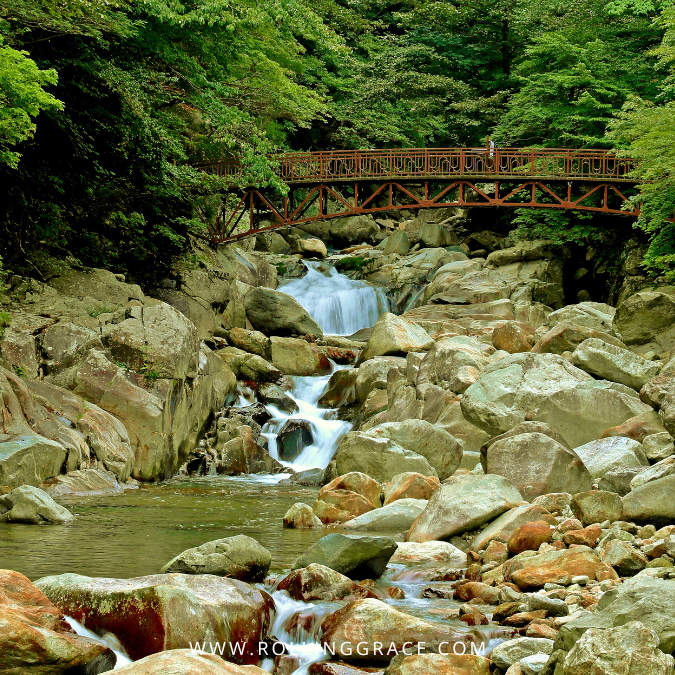Jirisan National Park, South Korea
Jirisan National Park is a true gem hidden in the heart of South Korea. This breathtaking park is home to towering peaks, cascading waterfalls, and dense forests that stretch as far as the eye can see. It is an ideal destination for those seeking to reconnect with nature and escape the hustle and bustle of modern life.
From the summit of Jirisan, the highest peak in the park, hikers can enjoy panoramic views of the surrounding landscape. The park is also home to an abundance of wildlife, including Asiatic black bears, deer and wild boars.
From the summit of Jirisan, the highest peak in the park, hikers can enjoy panoramic views of the surrounding landscape. The park is also home to an abundance of wildlife, including Asiatic black bears, deer and wild boars.
Whether you're a seasoned hiker or just looking for a peaceful retreat, Jirisan National Park offers something for everyone. Come, explore, and discover the natural beauty of Jirisan.
 |
| Jirisan National Park, South Korea |
Jirisan National Park, South Korea
History of Jirisan National Park
Nestled in the heart of South Korea, Jirisan National Park is a testament to the nation's rich history and cultural heritage. With ancient Buddhist temples and hiking trails dating back to the Silla Dynasty, Jirisan has played an important role in South Korean history for centuries.
The park's stunning vistas and pristine beauty have also inspired artists, poets, and writers throughout the ages, cementing its place as a cultural icon. As you traverse the park's winding paths and scenic trails, you can sense the deep-rooted history and reverence for nature that permeates every inch of Jirisan.
Jirisan Highest Peak
Cheonwangbong, or "King of Heaven Mountain," rises to 1,915 metres above sea level, making it South Korea's second highest peak after Hallasan (1,950 m) and the highest on the South Korean mainland. Many more peaks over 1,000 metres surround Jeonwangbong, including Jeseokbong (1,806 m), Banyabong (1,732 m), and Nogodan peak (1,507 m). During your visit, you can witness a panorama that appears to be a sea of mountains stretching off into the horizon.
Jirisan is regarded as one of South Korea's three most significant mountains, alongside Hallasan and Seoraksan. It is located in the southern end of the Sobaek mountain range.
 |
| Cheonwangbong is the highest peak in Jirisan |
How Long to Hike Jirisan
Jirisan features over ten incredible summits and several hiking trails. There are also incredible cascading waterfalls, including Guryongpokpo, Burilpokpo, Yongchupokpo, and Chilseonpokpo. The park is home to various important cultural sites, such as the famous Hwaeomsa Temple, Ssanggyesa Temple, and Daewonsa Temple.
Samshinbong is a popular but challenging trek from the Ssanggye Temple access point. You will go on a 2.3-kilometer trail that leads up from Ssanggyesa to the Buril Falls. The path continues 6.9 kilometres to the peak from the left turn on the path just before the waterfall. You can reach the peak in approximately four hours, and it takes a further three hours to go down through a rather steep trek. Remember to bring along plenty of water and snacks.
Other recommended hiking routes include the two-hour climb from Seongsamjae to the Nogodan ridge to arrive at the summit of Nogodan. Alternatively, there is an exciting summer trail which begins in Seongsamjae and continues along the Nogodan ridge to Hwaeomsa Temple over a five-hour journey. For seasoned hikers, the seven-hour trail from Piagol valley to Imgeollyeong is a must-try to get a taste of the splendour of Korean autumn.
 |
| Samshinbong is a popular but challenging hiking trail in Jirisan |
Wildlife & Plants
Jirisan is home to more than 1,500 plants, 122 species of birds, 24 species of mammals, 10 species of amphibians, 10 species of reptiles, 42 species of fish, 5,000 types of insects, and many more. It is South Korea's most diverse ecosystems and habitats. Asiatic black bears, Yellow-throated martens, otters, and flying squirrels are four rare and unique species found here.
Ever since the South Korean government have started releasing bears into Jirisan National Park, it is thought that at least 74 Asian black bears are living here. Those who plan to travel to Jirisan National Park may come across these adorable Asian black bears as they explore the trails.
 |
| Asian black bears at the Jirisan National Park in South Korea |
Entrance Fees
Admission Fee
Adult 1,000 won
Teenager 600 won
Children 300 won
Parking
Small cars: 2,000 won
Mid-size cars: 4,000-5,000 won
Large cars: 6,000-7,500 won
Camping
Adults 1,600-2,000 won
Teenagers 1,200-1,500 won
Children 800-1,000 won
How to Get to Jirisan National Park
By Bus
The best way to get to Jirisan is via vehicle or bus. Many buses from Busan depart from Seobu Terminal, including two daily buses to Ssanggyesa, four daily buses to Jungsan-ri, and one every other hour to Gurye. Local buses can transport you to the park's entrance from there. These cities are also accessible from other cities such as Jeonju, Gwangju, and Daegu.
By Train
The nearest and most convenient train station to Jirisan is 1 Gurye-gu Station. Gurye-gu Station is on the west side of Jirisan Mountain, making it easy to reach the beginning site of the HwaeomsaTemple and Nogodan Route. When you arrive at Gurye-gu Station, take a bus to Gurye Bus Terminal from the bus stop visible as soon as you exit. It takes around ten minutes and costs 1,000 won 1,500 won.
Don't forget to share your travel & dining moments with us on Instagram by tagging @rollinggrace or #RollingGrace. Happy travelling!










Such beautiful scenery and looks so peaceful. Should I go or not? Lemme think ya. Thanks for the sharing.
ReplyDeleteThis comment has been removed by the author.
ReplyDeleteWill visit this national park on my next trip to south korea
ReplyDelete